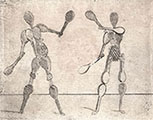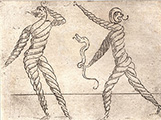Active in Florence, Livorno and Rome in the first half of 17th century
The details of Bracelli’s life are few. He was trained as a painter in Florence in the early years of the seventeenth century and is recorded on the membership records of the Accademia del Disegno from 1619 to 1635. Bracelli studied with Jacopo da Empoli and from 1616–17 assisted him with the decorations of a room in the Casa Buonarroti in Florence. He continued to work with Empoli from 1619 to 1623 on decorations for the cathedral in Livorno. In the following year he produced in Livorno the rare series of etchings for which he is best known: Bizzarie di Varie Figure. The fifty tiny etchings are among the most brilliant inventions of Italian Mannerism in the art of printmaking and were certainly influenced by Jacques Callot's activity as an etcher in Florence. The plates show a variety of human figures mainly interacting in pairs, their bodily forms composed of a range of objects, mostly abstract as cubes and squares, but also such real things as rackets, screws, etc. These sketches by Bracelli truly seems to prefigure a certain way of thinking about the human form that would not be explored again for many centuries later. After the publishing of the Bizzarie in Livorno we know of Bracelli only from the eighty-eight etchings he made from 1624 to about 1649, some of them made in Rome. No work is known after 1649, and the date and place of his death remain mysteries.
For more info on Bracelli we highly recommend this essay by Sue Welsh Reed.

